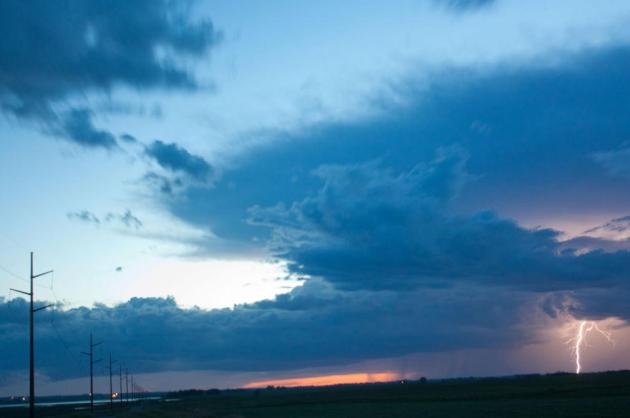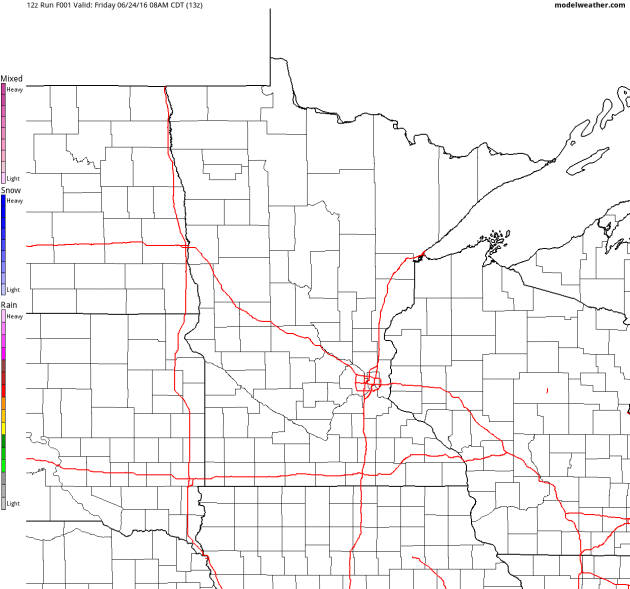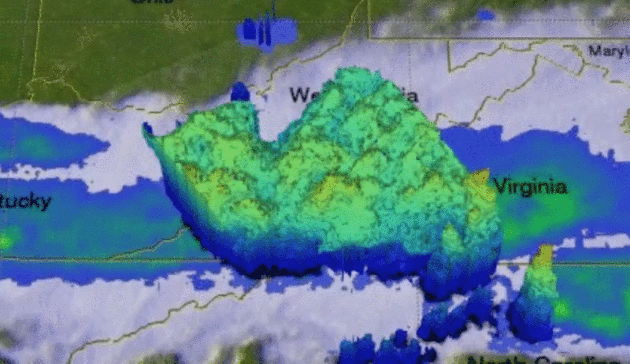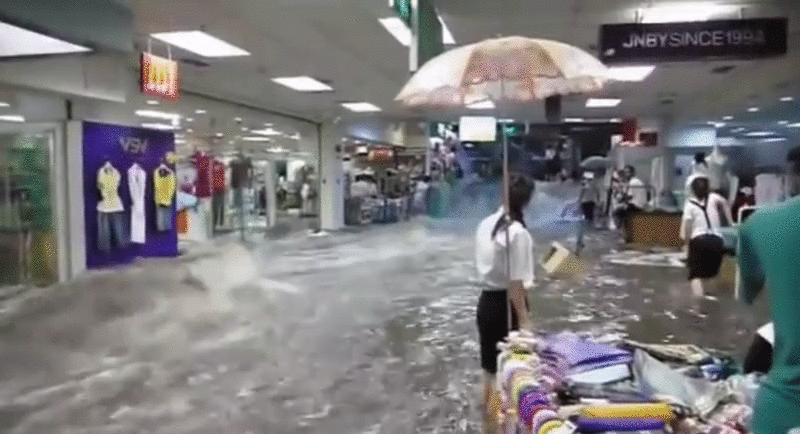82 F. high Friday in the Twin Cities.
82 F. average high on June 24.
78 F. high on June 24, 2015.
June 25, 2003: Heavy rain falls across central Minnesota. Elk River picks up 8.19 inches. 4.36 inches fall in 4 hours in Maplewood, and there are reports of street flooding in St. Paul. Strong winds topple trees in Richfield.
June 25, 1950: Flooding hits Warroad. Strong winds accompany waters that rose 4 feet in 10 minutes.

Enhanced Severe Storm Risk Today – Quiet Sunday
It’s a Wheel of Misfortune – a Dark Lotto, where losing towns get publicity they never wanted & homeowners spend anxious hours on the phone with insurance companies.
In spite of supercomputers and sophisticated Doppler radar algorithms there’s still no way to predict, more than a few minutes in advance, which communities will get whacked.
It’s a little like a sneeze. You may feel one coming on, but exactly where and when you’re going to “KA-CHOO”? Good luck.
A tropical stew of instability, dew points in the 70s and wind shear sets the stage for severe storms today. There will be watches and warnings for large hail, damaging straight-line winds, even a few tornadoes. Stay alert out there after 2 pm or so.
A wind shift to the west dries us out tomorrow with highs in the mid-80s. More sun, fewer sirens. A splash of Canadian air cools us into the 70s much of next week with comfortable dew points and little rain.
4th of July? It’ll fall on the 4th again this year. Odds favor some sun with a high near 80F at KMSP. No baking heat. No snow flurries.
My fingers (and eyes) are crossed.
Severe Saturday. With temperatures near 90F by early afternoon, a dew point in the low to mid 70s, significant instability and sufficient wind shear the risk of severe storms by afternoon will be considerable. The primary threat will be 60-75 mph straight-line winds and 1-2″ diameter hail, but supercells forming out ahead of the main squall line may spin up a few tornadoes this afternoon. Map: NOAA SPC.

Afternoon Squall Line. The chance of showers and strong to severe storms will increase in the metro by late afternoon and evening as a line of heavy weather sweeps across the state. 4 KM NAM Future Radar courtesy of NOAA and AerisWeather.
Comfortable Next Week. 70s in late June and the first few days of July? Not too hard to take, considering dew points drop into the 50s, even 40s up north – about as comfortable as it ever gets in mid-summer. ECMWF (European) data hints at 91F this afternoon; nearly 20 degrees cooler by Monday. Source: WeatherBell.
Ample June Rains for Most of Minnesota. Dr. Mark Seeley takes a look at an increasingly volatile June, statewide. Here’s an excerpt of this week’s edition of Minnesota WeatherTalk: “…Thanks to heavy rains from thunderstorms, many climate observers are reporting over 5 inches of rain for the month of June, and a handful like Hutchinson, Mankato, New Ulm, Redwood Falls, Preston, and La Crescent have received over 6 inches. Though many observers are reporting above normal rainfall for this month, some areas of west-central Minnesota, especially from Wilkin to Lac Qui Parle Counties, remain drier than normal with rainfall deficiencies ranging from 3-5 inches since May 1st. Some farmers in Brown, Redwood, Renville, and Stearns Counties were assessing hail damage to corn and soybean fields. The University of Minnesota Extension has published some guidelines on assessing such damage for determining whether to replant fields…”
* The latest Drought Monitor update is here.

NASA Analysis of West Virginia Flood Event. Another 1-in-1,000 year rainfall event? Once again weather systems essentially stalled, with training storms dropping repeated bouts of heavy rain over the same (waterlogged) counties. Here’s an excerpt from NASA’s Precipitation Measurement Missions: “…GPM captured this image of the East-West oriented line of storms at 9:41 pm EDT on Thursday June 23rd (01:41 UTC 24 June 2016). The image shows rain rates derived from the GPM GMI (outer swath) and DPR (inner swath) overlaid on enhanced IR data from the GOES-East satellite. By this time, most of the heavy rain was located over southern Virginia along the border with North Carolina where rates are shown to exceed 50 mm/hr (~2 inches/hr, shown in dark red). Meanwhile a broad area of light to moderate rain (blue and green areas) stretches from the Atlantic Coast all the way through southern West Virginia and back into central Kentucky.…”
Could a United Kingdom Exit From The EU Affect Weather Forecasts? What, if any, effect on ECMWF, the world’s leading weather model? Here’s an excerpt of a post from Dr. Marshall Shepherd at Forbes: “…I have no insight on how this vote affects the weather community but a “common sense” twitch in me suggests there could be some effects. While that ultimately remains to be seen, there are aspects worth noting about the United Kingdom (UK) and European Union as they pertain to the global weather enterprise. It is well-known in weather circles that the European Center for Medium-Range Weather Forecasting (ECMWF) or “Euro” model is the leading weather forecasting model in terms of numerous metrics for skill. I am often amused at the passionate discussion about this...”
* Here’s a link to a statement from ECMWF about England’s decision to leave the EU.
April and May 2016 Continue Record-Setting Heat. NASA’s Jet Propulsion Laboratory has an update; here’s the intro: “April and May 2016 set new global temperature records for those two months, continuing a trend of the previous six months, according to NASA’s Goddard Institute for Space Studies (GISS). The global temperature for April was 1.96 °F (1.09 °C) warmer than the average for April from 1951 to 1980, which is used as a base period. The global temperature for May was 1.67 °F (0.93 °C) warmer than the May base period. Every month since October 2015 has broken the record for that month. GISS director Gavin Schmidt estimated a greater than 99 percent probability that 2016 as a whole will set a new heat record…”
Image credit: Earth Science and Remote Sensing Unit, NASA Johnson Space Center.
Hottest Days Come in Mid-July. It may seem counterintuitive, but the hottest weather doesn’t come on the Summer Solstice, when the sun angle is highest in the sky. There is a built-in “lag” in the atmosphere, as water takes longer than land to heat up, and historically the hottest days of summer come 2-3 weeks after the solstice, in mid-July. Graphic credit: Climate Central.

Shopping for Dry Clothes. Check out the flash flooding in an underground shopping mall in Jinan, China. The shoppers look fairly calm – I’d be screaming like a schoolgirl. Details and video via YouTube: “Back on a milestone for customers Ginza shopping center in Jinan in China, who have been trapped by a terrible flood caused by floods. It is a true torrent that has formed in the galleries and shop shelves, causing damage and significant losses for sellers. The “Ginza Shopping Mall” is a large underground shopping center, with an area of over 40,000 square meters and is located in the heart of Jinan Springs Plaza.”
A Record 66 Million Trees Have Died in California, Increasing Fire Risk. Four years of severe drought have taken a toll, as reported at USA TODAY: “California is a tinderbox of dead trees, which is fueling the fire risk in the state. According to a report released Wednesday, 26 million trees have died in the southern Sierra Nevada since October 2015. The deaths are in addition to the 40 million trees that died across the state from 2010 to October 2015, bringing the total to at least 66 million dead trees. The report, which was prepared by the U.S. Forest Service, was released as several wildfires continue to char thousands of acres across the state, with thousands of Californians ordered to flee their homes...”
Photo credit: “Dead trees are seen near Bass Lake in the Sierra National Forest.” (Photo: U.S. Forest Service).
American Drivers Regain Appetite for Gas Guzzlers. Here’s the intro to a New York Times story: “The single most effective action that most Americans can take to help reduce the dangerous emissions that cause climate change? Buy a more fuel-efficient car. But consumers are heading in the opposite direction. They have rekindled their love of bigger cars, pickup trucks and sport utility vehicles, favoring them over small cars, hybrids and electric vehicles, which are considered crucial to helping slow global warming...”
72% of Corporations Are Actively Procuring Clean Energy. Here’s the intro to a piece at Greentech Media: “Cheaper renewable energy is allowing more corporations to look at options for generating their own power. But corporate sustainability mandates, rather than price alone, remain the primary driver of those purchasing decisions, according to a new survey from PwC. Seventy-two percent of companies surveyed said they are actively procuring renewable energy, mainly wind and solar. For those that are buying renewables, nearly half have specific renewable energy goals, although the attractive payback was the second-biggest driver for seeking out clean energy...”
Who Will Build The Next Great (Driverless) Car Company? Will car ownership truly be optional within 5-10 years as a majority of people simply hail the nearest (autonomous, driverless) vehicle in their zip code? Here’s an excerpt of a story at Fortune: “…Back then the idea of self-driving cars looked, to Ford’s leadership, like a frivolous Silicon Valley moonshot. Four years later things have dramatically changed. Today Ford’s vehicle lineup features more than 30 options for semiautonomous features, including the automatic brakes I tested, and the company is aggressively working on cars that fully drive themselves. By year-end the company expects to have the largest fleet of autonomous test vehicles of any automaker. Ford is not alone. The entire automotive industry is in the midst of a radical transformation that is reshaping the very definition of what it means to be a car company. There is hype, hope, fear, and insecurity—and at the center of it all is the self-driving car…”
Photo credit: “A Ford Fusion Hybrid autonomous research vehicle.” Photo: Courtesy of Ford Motors.
The Return of the Machinery Question. Is AI (artificial intelligence) the dawn of a new age of computer-amplifed productivity and growth, or the start of a new wave of job disruption? The Economist has an interesting article; here’s an excerpt: “…Today the machinery question is back with a vengeance, in a new guise. Technologists, economists and philosophers are now debating the implications of artificial intelligence (AI), a fast-moving technology that enables machines to perform tasks that could previously be done only by humans. Its impact could be profound. It threatens workers whose jobs had seemed impossible to automate, from radiologists to legal clerks. A widely cited study by Carl Benedikt Frey and Michael Osborne of Oxford University, published in 2013, found that 47% of jobs in America were at high risk of being “substituted by computer capital” soon…” (Image: Michael Morgenstern).
I Have Found a New Way to Watch TV, And It Changes Everything. TV on fast-forward? Jeff Guo explains at The Washington Post: “I have a habit that horrifies most people. I watch television and films in fast forward. This has become increasingly easy to do with computers (I’ll show you how) and the time savings are enormous. Four episodes of “Unbreakable Kimmy Schmidt” fit into an hour. An entire season of “Game of Thrones” goes down on the bus ride from D.C. to New York. I started doing this years ago to make my life more efficient. Between trendy Web shows, auteur cable series, and BBC imports, there’s more to watch ever before. Some TV execs worry that the industry is outpacing its audience. A record-setting 412 scripted series ran in 2015, nearly double the number in 2009...”
While Brazil Was Eradicating Zika Mosquitoes, America Made Them Into Weapons. I had no idea – check out a story at Atlas Obscura: “…Even while American money was funding eradication efforts, led by Americans, in countries further south, the American government was one of the last holdouts in the hemisphere-wide effort to destroy A. aegypti. At the same time as the U.S. Public Health Service at last started trying to eradicate Aedes aegypti from the southeast, another branch of the U.S. government was planning to raise colonies of millions of A. aegypti mosquitos, to use as biological weapons…”
Image credit: “The mosquitoes won.” Photo: James Gathany/CC BY 2.0
TODAY: Very humid with some hot sun. PM T-storms, some turn severe. Winds: S 15-25. High: 90
SATURDAY NIGHT: Strong to severe T-storms into late evening, drying out late. Low: 66
SUNDAY: Sunnier, drier – the nicer day. Gusty west winds at 15-25+ High: 85
MONDAY: Partly sunny, comfortable breeze. Winds: NW 10-20. Wake-up: 62. High: 75
TUESDAY: Sunny and glorious. Light winds. Winds: NW 5-10. Wake-up: 57. High: 77
WEDNESDAY: Less sun, isolated shower? Winds: S 7-12. Wake-up: 60. High: 79
THURSDAY: Unsettled, risk of a thundershower. Winds: SW 7-12. Wake-up: 63. High: 81
FRIDAY: Partly sunny, lukewarm. Winds: SE 5-10. Wake-up: 65. High: 83
Climate Stories…
Why the GOP is Trying to Stop the Pentagon’s Climate Plan. Politico attempts to explain the inexplicable; here’s an excerpt: “…This is what we ask our military and national security people to do, to think long-term, look at emerging threats, figure out ways to protect against these threats,” he said. DOD officials have been warning for years that climate change could have dire consequences on U.S. national security. Increased refugee flows, which are already straining Europe, are likely to accelerate as the climate heats up and have the potential to destabilize large swaths of the world, including the Middle East and South Pacific. The “oil wars” of the 20th century could give way to “water wars,” with countries competing for scarce natural resources. Higher energy costs may further strain the military’s budget and rising water levels could force the DOD to adjust locations of critical infrastructure facilities like ports…”
Forest Fires Can Heat Up The Whole Planet. A story at National Geographic explains how NASA is tracking the accelerating changes: “…Climate change is playing out twice as fast in the boreal forest than it is on the rest of the planet. Permafrost is thawing, and vegetation is changing as climatic zones migrate north faster than trees can adapt. Already, dramatic change can be glimpsed from space: The tundra is turning green, while the boreal forest is turning brown. Some scientists predict the boreal forest may reach a disastrous—and irreversible—tipping point this century and shift from carbon storehouse into a major source of greenhouse gas emissions. Others contend that the tipping point has already been reached...”
Climate Change Could Put Major Boston Landmarks Under Water. Curbed Boston has a post; here’s a clip:”A new report from the University of Massachusetts and other local universities paints a particularly grim picture of the effects of climate change on Boston. Seas around the city could rise as much as 10.5 feet by 2100—that’s 84 years from now—and an astounding 37 feet by 2200. To put that in perspective, Faneuil Hall now floods at high tide at 5 feet and Copley Square at 7.5 feet, according to David Abdel at the Globe. The higher sea levels could pretty much doom these and other notable Boston sites...”

Guest Post: Three Ways to Boost Crop Resilience to Climate Change. Carbon Brief looks at new and emerging best practices – focusing on corn; here’s an excerpt: “Feeding a growing global population as our climate warms will be one of the biggest challenges that we face during this century. Introducing new crop varieties that thrive in warmer conditions can help farmers make their crops more resilient. But our new study suggests the climate is changing faster than new crops are being developed. Using maize crops in Africa as a case study, we look at three ways to help crop yields keep pace with rising temperatures, protecting food production in the future...” (Photo credit: Tim McCabe, USDA).
Why The Climate Change Fight Needs a New Type of Entrepreneur. Here’s a clip of an interesting post from The University of California: “…Even the increasing rate of natural disasters has a silver lining for Carter. Disasters can free up money for quick action, sidestep political hurdles, increase a problem’s visibility and provide an opportunity to rebuild in a sustainable way. “You can use the huge influx of cash from natural disasters to cause change to happen on a much faster timescale than is normally possible,” said Carter. “If you’re going to rebuild a home with insurance money, you can now build back your home in a completely net-zero way. In fact, you can even generate extra electricity, so it’s better than net-zero...”
Photo credit: Elene Zhukova. “UC Santa Cruz Professor and entrepreneur Sue Carter thinks the time is right for a big impact from entrepreneurs in clean energy.”
Everything Is Bigger in Texas, Including the Floods. Check out the video and story excerpt from Nexus Media and Popular Science: “…America’s fourth-largest city suffered through a downpour of biblical proportions—storms delivered more rain in a single day than any hurricane in the history of the city. Floods stole dozens of lives and incurred billions in damages. Scientists have drawn a link between rising temperatures and increased precipitation. A warmer atmosphere can hold more water vapor and deliver heavier downpours. As the planet heats up, Houston can expect more severe rainfall…”

A Peek Into the Relatively Sane Climate Debates Outside the United States. Grist takes a look at how conservative parties in just about every other country on Earth have accepted the science and are now focusing on solutions: “…Norwegian researcher Sondre Båtstrand last year compared conservative parties in the United Kingdom, Norway, Sweden, Spain, Canada, New Zealand, Germany, and Australia, finding that the U.S. Republican Party alone was “an anomaly in denying anthropogenic climate change.” Even when conservative candidates argue against climate-change action in their home countries, scientific denial is rarely part of the conversation. Here’s a whirlwind tour of the climate and energy debate around the world (which is thoroughly blissful compared to U.S. politics)..” (Image credit: NASA).

